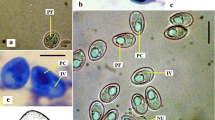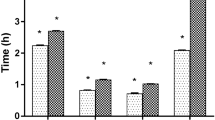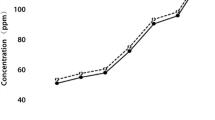Abstract
Dactylogyrus spp. and Gyrodactylus spp. are helminth ectoparasites that are a significant threat to the aquaculture industry. Existing treatments could cause the threats of anthelmintic resistance, risk of residues, environmental contamination, and toxicity to fish. Importantly, there is no report on a treatment against these two parasites. This study explored the possibility of using the extracts of Santalum album to treat Dactylogyrus sp. and Gyrodactylus sp. infections in goldfish. Results showed that among the four extracts (chloroform, methanol, ethyl acetate, and water) of S. album, the chloroform extract is the most effective and 40 mg/L is a safe and the lowest effective dosage. In addition, we found that Gyrodactylus elegans is more sensitive than Dactylogyrus intermedius when exposed to the extract of the medicinal plant. Finally, it is substantiated that bath treatment with long duration and multiple administrations could eliminate a greater proportion of monogenean infections. These findings show the potential for the development of effective and safe therapy to treat Dactylogyrus sp. and Gyrodactylus sp. infections of fishes.


Similar content being viewed by others
References
Asakawa Y, Noma Y (2010) Biotransformation of sesquiterpenoids. In: Can Baser G, Buchbauer KH (eds) Handbook of essential oils. CRC, New York
Banerjee S, Ecavade A, Rao AR (1993) Modulatory influence of sandalwood oil on mouse hepatic glutathione S-transferase activity and acid soluble sulphydryl level. Cancer Lett 68:105–109
Bauer ON (1961) Parasitic diseases of cultured fishes and methods of their prevention and treatment. In: Dogiel VA, Petrushevski GK, Polyanski YUI (eds) Parasitology of fishes. Oliver & Boyd, Edinburgh
Benencia F, Courrèges MC (1999) Antiviral activity of sandalwood oil against herpes simplex viruses-1 and -2. Phytomed 6:119–123
Buchmann K, Kristensson RT (2003) Efficacy of sodium percarbonate and formaldehyde bath treatments against Gyrodactylus dejavini infestations of rainbow trout. N Am J Aquacult 65:25–27
Cone DK, Odense PH (1984) Pathology of 5 species of Gyrodactylus Nordmann, 1832 (Monogenea). Can J Zool 62:1084–1088
Crigel P, Losson B, Defour J (1995) The antiparasitic efficacy of quinaldine, an anesthetic agent in fish. Ann Med Vet 139:343–348
DeLorenzo ME, Serrano L, Chung KW, Hoguet J, Key PB (2006) Effects of the insecticide permethrin on three life stages of the grass shrimp, Palaemonetes pugio. Ecotoxicol Environ Saf 64:122–127
Dwivedi C, Abu-Ghazaleh A (1997) Chemopreventive effects of sandalwood oil on skin papillomas in mice. Eur J Cancer Prev 6:399–401
Dwivedi C, Zhang Y (1999) Sandalwood oil prevents skin tumor development in CD1 mice. Eur J Cancer Prev 8:449–456
Dwivedi C, Valluri HB, Guan X, Agarwal R (2006) Chemopreventive of α-santalol on ultraviolet B radiation-induced skin tumor development in SKH-1 hairless mice. Carcinogenesis 27:1917–1922
George AB, Ioana GC (2008) Safety assessment of sandalwood oil (Santalum album L.). Food Chem Toxicol 46:421–432
Goven B, Gilbert J, Gratzek J (1980) Apparent drug resistance to the organophosphate dimethyl (2,2,2-trichloro-1-hydroxyethyl) phosphonate by monogenetic trematodes. J Wildl Dis 16:343–346
Heggberget TG, Johnsen BO (1982) Infestations by Gyrodactylus sp. of Atlantic salmon, Salmo salar L., in Norwegian rivers. J Fish Biol 21:15–26
Ji J, Lu C, Kang YJ, Wang GX, Chen P (2012) Screening of 42 medicinal plants for in vivo anthelmintic activity against Dactylogyrus intermedius (Monogenea) in goldfish (Carassius auratus). Parasitol Res 111:97–104
Kaur M, Agarwal C, Singh RP, Guan X, Dwivedi C, Agarwal R (2005) Skin cancer chemopreventive agent, α-santalol, induces apoptotic death of human epidermoid carcinoma A431 cells via caspase activation together with dissipation of mitochondrial membrane potential and cytochrome c release. Carcinogenesis 26:369–380
Kim TH, Ito H, Hatano T, Takayasu J, Tokuda H, Nishino H, Machiguchi T, Yoshida T (2006) New antitumor sesquiterpenoids from Santalum album of Indian origin. Tetrahedron 62:6981–6989
Klinger R, Floyd RF (2002) Introduction to freshwater fish parasites, Document CIR716. Institute of Food and Agricultural Science. University of Florida, Florida
Liu YT, Wang F, Wang GX, Han J, Wang Y, Wang YH (2010) In vivo anthelmintic activity of crude extracts of Radix angelicae pubescentis, Fructus bruceae, Caulis spatholobi, Semen aesculi, and Semen pharbitidis against Dactylogyrus intermedius (Monogenea) in goldfish (Carassius auratus). Parasitol Res 106:1233–1239
Lu C, Zhang HY, Ji J, Wang GX (2012) In vivo anthelmintic activity of Dryopteris crassirhizoma, Kochia scoparia, and Polygala tenuifolia against Dactylogyrus intermedius (Monogenea) in goldfish (Carassius auratus). Parasitol Res 110:1085–1090
Margolis L, Esch GW, Holmes JC, Kuris AM, Schad GA (1982) The use of ecological terms in parasitology. J Parasitol 68:131–133
Matsuo Y, Mimaki Y (2010) Lignans from Santalum album and their cytotoxic activities. Chem Pharm Bull 58:587–590
Matsuo Y, Mimaki Y (2012) α-Santalol derivatives from Santalum album and their cytotoxic activities. Phytochem 77:304–311
Morris JA, Khettry A, Seitz EW (1979) Antimicrobial activity of aroma chemicals and essential oils. J Am Oil Chem Soc 56:595–603
Ochi T, Shibata H, Higuti T, Kodama K, Kusumi T, Takaishi Y (2005) Anti-helicobacter pylori compounds from Santalum album. J Nat Prod 68:819–824
Ohmori A, Shinoyama K, Utsu Y, Yokunaga S, Hasegawa Y, Kamei C (2007) Effect of santalol on the sleep-wake cycle in sleep-disturbed rats. Jpn J Neuropsychopharmacol 27:167–171
Petrushevski GK, Shulman SS (1961) The parasitic diseases of fishes in the natural waters of the USSR. In: Dogiel VA, Petrushevski GK, Polyanski YI (eds) Parasitology of fishes. Oliver & Boyd, Edinburgh
Poléo ABS, Schjolden J, Hansen H, Bakke TA, Mo TA, Rosseland BO, Lydersen E (2004) The effect of various metals on Gyrodactylus salaris (Platyhelminthes, Monogenea) infections in Atlantic salmon (Salmo salar). Parasitol 128:169–177
Rach JJ, Gaikowski MP, Ramsay RT (2000) Efficacy of hydrogen peroxide to control parasitic infestations on hatchery-reared fish. J Aquat Anim Health 12:267–273
Reed PA, Francis-Floyd R, Klinger RC (2009) Monogenean parasites of fish. http://edis.ifas.ufl.edu/FA033. Accessed 17 May 2009
Santamarina MT, Tojo J, Ubeira FM, Quinteiro P, Sanmartin ML (1991) Anthelmintic treatment against Gyrodactylus sp. infecting rainbow trout Oncorhynchus mykiss. Dis Aquat Org 10:39–43
Schäperclaus W (1991) Fish diseases, 5th edn. Oxonian, New Delhi
Schmahl G, Mehlhorn H (1985) Treatment of fish parasite. 1. Praziquantel effective against Monogenea (Dactylogyrus vastator, Dactylogyrus extensus, Diplozoon paradoxum). Z Parasitenk 71:727–737
Schmahl G, Mehlhorn H, Haberkorn A (1988) Sym. triazinone (toltrazuril) effective against fish-parasitizing Monogenea. Parasitol Res 75:67–68
Scholz T (1999) Parasite in cultured and feral fish. Vet Parasitol 84:317–335
Soleng A, Poléo ABS, Alstad NEW, Bakke TA (1999) Aqueous aluminium eliminates Gyrodactylus salaris (Platyhelminthes, Monogenea) infections in Atlantic salmon. Parasitol 119:19–25
Steverding D, Morgan E, Tkaczynski P, Walder F, Tinsley R (2005) Effect of Australian tea tree oil on Gyrodactylus spp. infection of the three-spined stickleback Gasterosteus aculeatus. Dis Aquat Org 66:29–32
The Editorial Committee of the Administration Bureau of Traditional Chinese Medicine (1999) Chinese material medica (Zhonghua Bencao). Shanghai Science and Technology, Shanghai
Thoney DA, Hargis WJ (1991) Monogenea (Platyhelminthes) as hazards for fish in confinement. Annu Rev Fish Dis 1:133–153
Treves-Brown KM (1999) Availability of medicines for fish. Fish Vet J 4:40–50
Wang GX, Zhou Z, Cheng C, Yao JY, Wang ZW (2008) Osthol and isopimpinellin from Fructus cnidii to control Dactylogyrus intermedius in Carassius auratus. Vet Parasitol 158:144–151
Williams HH, Jones A (1994) Parasitic worms of fish. Taylor & Francis, London
Woo PTK, Bruno DW, Lim LHS (eds) (2002) Diseases and disorders of finfish in cage culture. CABI, Wallingford
Wu ZF, Zhu B, Wang Y, Lu C, Wang GX (2011) In vivo evaluation of anthelmintic potential of medicinal plant extracts against Dactylogyrus intermedius (Monogenea) in goldfish (Carassius auratus). Parasitol Res 108:1557–1563
Yi YL, Lu C, Hu XG, Ling F, Wang GX (2012) Antiprotozoal activity of medicinal plants against Ichthyophthirius multifiliis in goldfish (Carassius auratus). Parasitol Res 111:1771–1778
Zhang X, Chen W, Guillermo R, Chandrasekher G, Kaushik RS, Young A, Fahmy H, Dwivedi C (2010) Alpha-santalol, a chemopreventive agent against skin cancer, cause G2/M cell cycle arrest in both p53-mutated human epidermoid carcinoma A432 cells and p53 wild-type human melanoma UACC63 cells. BMC Res Notes 3:220–235
Acknowledgments
Financial support for this study was provided by the National High Technology Research and Development Program of China (also called 863 Program) under Grant 2011AA10A216.
Author information
Authors and Affiliations
Corresponding authors
Rights and permissions
About this article
Cite this article
Tu, X., Ling, F., Huang, A. et al. Anthelmintic efficacy of Santalum album (Santalaceae) against monogenean infections in goldfish. Parasitol Res 112, 2839–2845 (2013). https://doi.org/10.1007/s00436-013-3455-7
Received:
Accepted:
Published:
Issue Date:
DOI: https://doi.org/10.1007/s00436-013-3455-7




